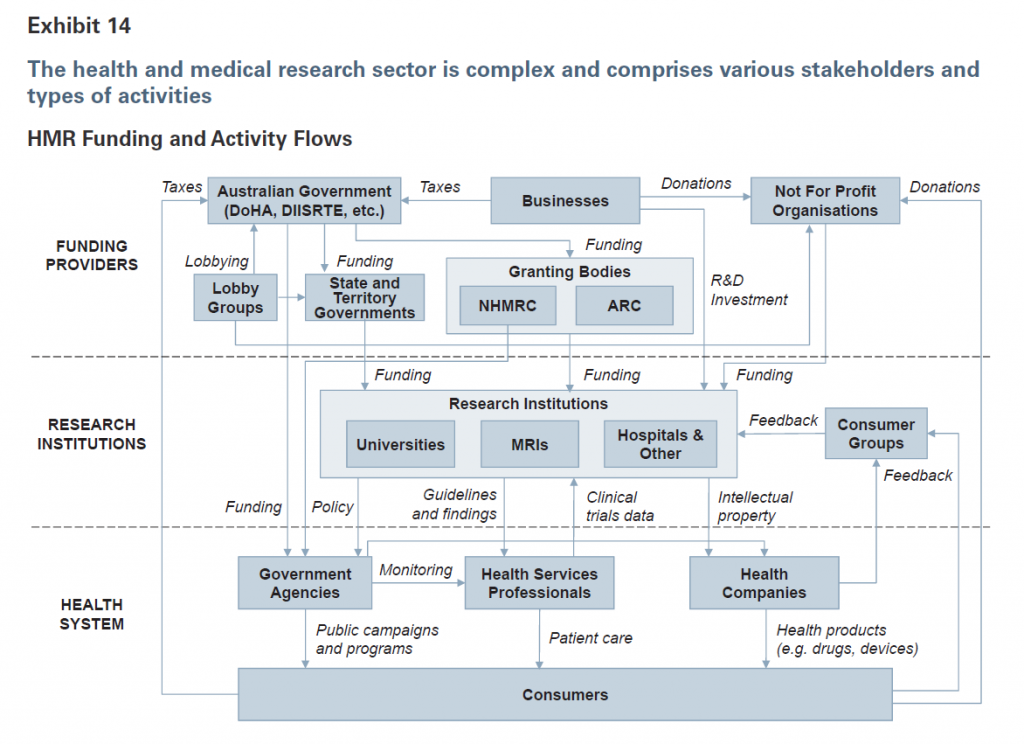“After 19 months, the review panel still didn’t have an answer to the critical question of how much is spent on health and medical research …”
-From an interview with Simon McKeon, Chair of the Strategic Review of Health and Medical Research in Australia (McKeon Review).
Australia excels in health and medical research (HMR). Our success in this area is well established. From pioneering the development of artificial heart valves to ground-breaking treatment of spinal cord injuries, this success is a testament to the passion, dedication and skill of our HMR workforce. Success also depends on reliable, ongoing investment in the HMR sector. Investment in HMR has demonstrated benefits, both direct and indirect, for Australia’s economic and social wellbeing. But this post is not about measuring these benefits or outputs of HMR investment, although estimates in financial terms suggest at least $2.17 for every dollar and in non-financial terms the value is immeasurable. Instead, this post considers the difficulties and ambiguities that persist when measuring total financial inputs. Because an understanding of what goes in is vital to contextualising what comes out.
Health and Medical Research Expenditure

Released in February 2013, the McKeon Review marked the most comprehensive analysis of the health and medical research (HMR) sector since the Wills Review in 1998. McKeon’s words above highlight one of the panel’s most alarming takeaways. At the end of the review period, despite the “combined insights of thousands of individuals who contributed their ideas and time”, meeting with “over 300 individuals from universities, MRIs, governments, hospitals, businesses and not-for-profit organisations” and receiving 400 written submissions, the panel were not able to make a confident assessment of total HMR spending.
The query seems simple enough: how much is spent on HMR research each year and by whom? It’s now four years since the release of the review and this assessment is no easier to make. Why?
As it turns out, the Australian HMR landscape is as complex and fragmented as the health system it serves. The diagram below from the McKeon Review provides some context as to why the task of tracking expenditure data across this landscape is vexed. The McKeon Review reported the scale and importance of the problem, as well as making recommendations for how it might be remedied. One recommendation was for a leadership body to be empowered as the ‘single source of truth’ on formal standards for tracking HMR funding and expenditure. This is yet to eventuate.

Source: Strategic Review of Health and Medical Research in Australia Summary Report, page 19.
Estimates from the McKeon Review put HMR expenditure at over $6 billion in 2011-2012. Very few estimates have been made in the years since. In January 2016, Research Australia used data from 2013-14 and came up with the figure $5.9 billion. Research Australia itself has acknowledged that the data used to arrive at this figure came with its own limitations and the amount may in fact be higher. They provided a thorough overview of both the methodological qualifications on their estimates and the broader HMR funding landscape. As with the McKeon Review estimates, Research Australia identified state and territory expenditure as particularly difficult to determine.
Without a consistent method for measuring HMR expenditure, judgment calls need to be made. To make meaningful comparisons across time these judgement calls need to be consistent.
What are some of the issues with measuring HMR expenditure?
- data must be pieced together from a range of sources and sectors
- data availability varies across different sectors
- data sources reference different time periods
- data sources classify health research data differently i.e. by methodology ‘Field of Research’ (FOR) or intended outcome ‘Socio-economic Objective’ (SEO)
- data sources vary in degree of detail
- health-related research is undertaken across a range of disciplines
- what counts as health-related research is broad and inconsistently defined
- funding is provided for direct costs and indirect costs of research
- direct and indirect funding measures are used (i.e. grants vs tax incentives)
- the source of funds and the user of funds are often different
- funds are often provided in one year and spent in another
In light of these considerations, the table below outlines the best estimates using most recent data from ABS R&D expenditure tables. However, this data captures where funds are spent and not their source. This means that HMR spending by government appears to be low when in fact a large portion of the expenditure in other sectors is provided through government channels such as NHMRC grants.
The ABS R&D data from which expenditure is estimated is coded according to the Australian and New Zealand Standard Research Classification (ANZSRC). This system classifies R&D data in two ways.
- ‘Socio-economic Objective’ (SEO) – classifies R&D based on purpose or outcome.
- ‘Field of Research’ (FoR) – classifies R&D based on research methodology.
In making estimates of HMR expenditure the SEO of ‘Health’ is used to in all sectors except business. For business expenditure the FOR code ‘11 – Medical and Health Sciences’ is taken to be a more complete picture given that pharmaceutical and biomedical R&D is often recorded instead against a manufacturing SEO.

The McKeon Review called for a ‘single source of truth’ on formal standards for tracking HMR expenditure. This recommendation remains just as relevant four years later. With the first round of grants announced for the Medical Research Future Fund, the need for clarity on measurement of HMR expenditure is even greater. The better we understand the inputs of our HMR investment, the more confident we can be when considering and advocating for its outputs. Our success in the field of HMR is unambiguous. So too should be the investment that enables that success. This will ensure that Australia continues to maximise the value of HMR; as the R&D arm of the health system and a vital part of our economic and social wellbeing.



















